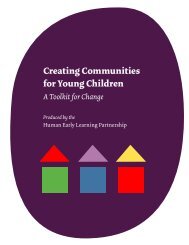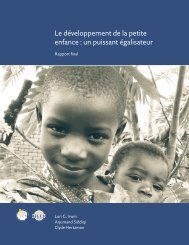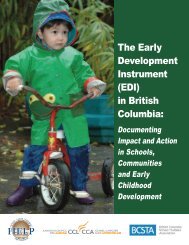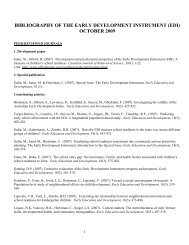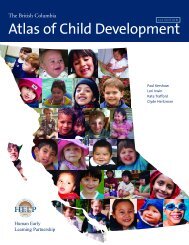Total Environment Assessment Model for Early Child Development
Total Environment Assessment Model for Early Child Development
Total Environment Assessment Model for Early Child Development
Create successful ePaper yourself
Turn your PDF publications into a flip-book with our unique Google optimized e-Paper software.
Family, Cultural, Economic, & Social <strong>Environment</strong>, Gender Roles, Family Health Status and Dwelling <strong>Environment</strong><br />
<strong>Total</strong> <strong>Environment</strong> <strong>Assessment</strong> <strong>Model</strong><br />
<strong>for</strong> <strong>Early</strong> <strong>Child</strong> <strong>Development</strong><br />
the earlierst years of life, differences in the<br />
extent of nurturance provided by children’s<br />
environmental conditions lead to differences<br />
in ecd outcomes; the effects of these early<br />
inequities last <strong>for</strong> a lifetime, and translate<br />
into inequities in health in later childhood,<br />
adolescence, and in adulthood. In sum, the<br />
socioeconomic environment is a fundamental<br />
determinant of ecd and, in turn, ecd is a<br />
determinant of health and well-being across<br />
the balance of the life course.<br />
Primary Principles of team-ecd<br />
Rooted in these universalities, team-ecd is<br />
based on three underlying principles:<br />
1) <strong>Early</strong> <strong>Child</strong> <strong>Development</strong>—physical,<br />
social/emotional, and language/cognitive—is<br />
the result of interactions between children’s<br />
biological factors and the environments in<br />
which children are embedded.<br />
2) Successful ecd occurs when environmental<br />
conditions—physical, social, and economic<br />
—demonstrate characteristics that are known<br />
to be ‘nurturant’ <strong>for</strong> children.<br />
3) Using an equity-based approach to provide<br />
nurturant environments <strong>for</strong> all children will<br />
lead to equity of <strong>Early</strong> <strong>Child</strong> <strong>Development</strong> and<br />
equity in well-being throughout the life course.<br />
team-ecd: Organizational<br />
Overview<br />
Figure 1 provides the heuristic depiction<br />
of team-ecd. team-ecd is organized by<br />
interacting and interdependent ‘spheres of<br />
influence.’ They include the individual sphere<br />
(which is the central sphere in the model and<br />
reflects the child itself, including her/his<br />
biological characteristics), the family and<br />
dwelling sphere, the residential community<br />
sphere, the relational community sphere, the<br />
ecd services sphere, the regional environmental<br />
sphere, the national environmental<br />
sphere, and the global environmental sphere.<br />
Each chapter in this study is devoted to<br />
describing one of these spheres of influence<br />
in terms of the aspects of each—physical,<br />
Introduction<br />
and Overview<br />
figure 1: team-ecd<br />
schematic<br />
Global Ecological, Corporate/Economic, Policy, Political and Social <strong>Environment</strong>s<br />
Civil Society<br />
Regional Health Status, Ecological, Economic, Policy, Political & Social <strong>Environment</strong>s<br />
Residential Community Health Status and Cultural, Economic, Service & Social <strong>Environment</strong>s<br />
National Health Status, Ecological, Economic, Policy, Political & Social <strong>Environment</strong>s<br />
Individual Brain and<br />
Biological <strong>Development</strong><br />
ecd Programmes<br />
and Services<br />
Genetics, Age,<br />
Sex, Gender<br />
Institutional /<br />
Historical Time<br />
Relational Community (Tribe, Religion, etc.) Health<br />
Status, Gender Socialization, Cultural <strong>Environment</strong><br />
and Socioeconomic Status & Resources<br />
15



